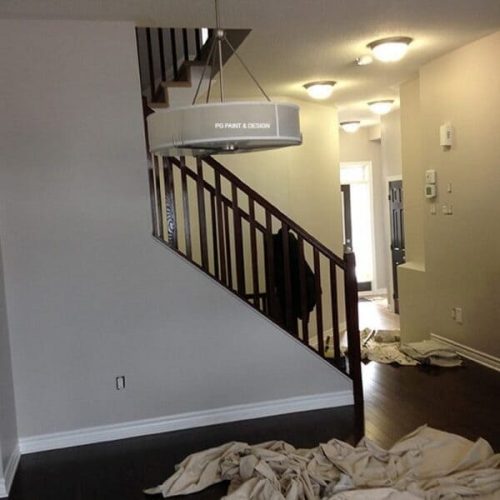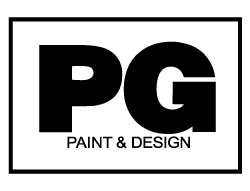As professional house painters in Ottawa we’ve seen it and heard it before so many times. The conviction most do it yourself painters have in believing that using a paint primer when painting any interior or exterior space is a total waste of their time and effort.

In this article we want to share with you the correct information you need to know so that you can make the best informed decision for the next time you’re planning a home painting project.
We will share the reasons why using a primer paint is an important first step to professional looking results. You will also learn when it is absoloutely necessary to use paint primers and when it’s ok to skip it.
When To Use A Paint Primer
All good painting contractors will use a primer before painting the minimum two coats of the finish paint. They know the importance of using the paint primers to help provide full coverage, hide imperfections, and that it helps the finishing paint colour bond better to the surface.
The best painters will tell you that using a paint primer help get the surface prepped for new paint, helps provide the most overall coverage, creates a good base for the final coat of paint and helps protect the longevity of the paint.
To get the best looking professional painting results on your next home painting projects here are the recommended times mportant times that the use of paint primers before painting are a must.
New Drywall – It is highly recommended that if you are building a new home, or have recently done renovations where new drywall has been installed, you must use a paint primer before applying any paint.
The reasoning behind using primer paints on new drywall is due to the facts that the materials in drywall products are very porous surfaces and omitting the use of primers will result in your needing more finishing paint coats to get complete coverage at much higher costs for buying paint.
A paint primer provides a good barrier and seal to the layer between the drywall and the final coat of paint, and it is therefore recommended as the preferred method rather than painting multiple coats of the final paint.
Stains – A paint primer is an easy, quick and effective way to ensure any type of stains are fully covered.
Applying the primer over a water stain or smoke stain before painting ensures that the stain is completely covered and will not show up. It gives the paint a layer to adhere to better and thus making the stain become invisible. Without using a primer first the smoke or water spots may bleed through the topcoat.
Unfinished Wood – It is highly recommended to use a primer paint when painting newly installed unfinished wood. Because the natural porous fibres of the unfinished wood will absorb many coats of paint without a good wood primer we would highly recommend application of a primer before any paint or stain to help cover up any of the natural knots found in wood. Using a good wood primer before the final coats of paint or stain will also provide the wood surfaces with a layer of sealant which help protect against any water damage.
Patching & Drywall Repairs – if you have had to repair major areas of drywall surfaces and applied a skim coat of drywall plaster, this is another instance where it is important to use a primer first.
The plaster or drywall compound is a porous surface that will soak up a lot of paint if a primer is not applied first. To help reduce the amount of paint you will need to get the best overall coverage we would recommend using a primer over the plaster skim coated area before applying any new paint.
Wallpaper – painting over wallpaper is completely possible however it is imperative to use a primer first especially if you have already removed the existing wallpaper.
Using a primer before painting over wallpaper allows for the correction of any flaws concealed from the removal of the wallpaper and helps create a smoother finish.
Water or Oil Based Paints – Painting with a latex or water-based paints over oil-based paints without using the right type of primer first could lead you into problems with paint.
Just like oil and water don’t mix well in a glass the same holds true for paint if you are trying to paint a latex or water-based paint over a pre-existing oil-based paint. To ensure that the new paint you apply adheres properly simply apply the paint primer first without attempting to skip the step.
Brick or Masonry – the high pH values, along with the natural elements of brick and other masonry being very porous surfaces with many crevices creates large problems with them soaking up larger than normal amounts of paint. To avoid using to much of the finish paint, we recommend you apply the proper brick paint primer first, to give it a solid base for which the final paint will properly adhere to.
Paint Finish – If you are painting over a previous paint finish that is glossy or high-gloss, it is imperative to use a primer before painting over with any other paint finish or paint colour. A glossy or high-gloss paint finish should always have a light hand sanding, followed by a primer paint to ensure the best adhesion of the new paint.
Paint Colours – Typically you can paint over the previous paint colours without much difficulty. However, if you are painting a light colour over a dark colour you should always use a paint primer first to help create a neutral base for the new paint colours to adhere to without leaving a dark shadow underneath.
Failure to use a primer first will run you the risk of having the darker colour show through the lighter one. It will also take you several coats of the lighter colour to get the full and proper coverage over the darker colour.
Bonus Tip: when purchasing paint primers ask for a tinted primer in the closest shade of the new colour you will be applying to help get the most and best coverage.
When You Don’t Need To Use A Paint Primer
There will be times where you do not need to use a primer first and we break down when you can skip it.
Repainting – If you are repainting the same colour just to freshen things up the need for using a primer is none. You can in this instance just paint the same colour over and get excellent coverage with just one coat.
Finished Wood – When painting over previously painted wood surfaces such as baseboards and trim it won’t be a big deal if you skip out the primer painting first, since 9 times out of 10 you will just be painting over an existing white paint colour for these areas. A primer would have already been used when they were first installed so painting directly over them with a finished paint colour will provide the results you’re looking for.
That is pretty much it. We would only recommend not using a primer first only if you are repainting a surface with the exact same colour.
To Prime or Not To Prime Before Painting
Knowing whether to use a primer paint or not depends on what you are painting as referred to in the article above.
If you’re a do-it-yourself painter know before you get started to help avoid the headaches that skipping one of the important steps to a perfect end result in your next home painting project can create.
If you don’t want the headaches of priming or painting yourself call on the professionals to get it done right.
If you live in the Ottawa area, give us a call or email to get a free consultation and painting quote.
